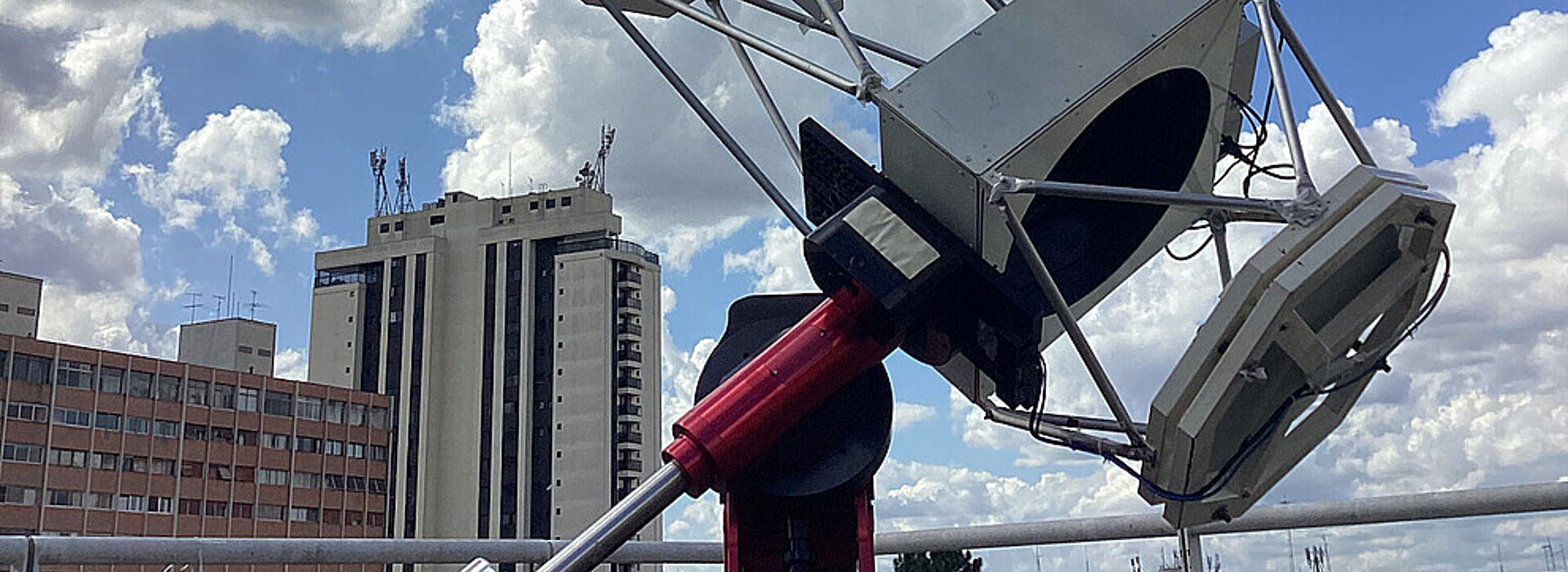
The Mackenzie Center for Radio Astronomy and Astrophysics (CRAAM), at Mackenzie Presbyterian University (MPU), developed the solar telescope for the mid infrared, called HATS, a world pioneer to observe the solar activity in this spectral band. On March 23, students from the School of Engineering (EE) at UPM visited the new equipment.
Professor Paulo Simões explained that the function of the new telescope is to monitor the solar activity. “The sun is not ‘calm’ all the time, just that yellow ball we see in the sky. The telescope measures the intensity of the mid-infrared emission so that we can understand how solar events work, which can cause different effects on Earth”, he highlighted.
The equipment will be sent to Argentina, to the Félix Aguilar Observatory (OAFA) in theAndes, one of the observatories with which Mackenzie has an agreement.
“The main focus of this visit is to show students that within the University there is cutting-edge technology with worldwide impact, the group has research with collaboration from all over the world. So, students should take advantage of the many opportunities that Mackenzie offers”, pointed out Professor Simões.
The visit also featured an introductory class by Professor Jean-Pierre Raulin, coordinator of CRAAM, presenting the history of the Center, which originated in 1960 as the Mackenzie Radio Astronomy Group (GRAM) of the then Faculty of Philosophy, Sciences and Letters of the UPM, incorporating the experimental activities of a group of students of physics, engineers, technicians, and aficionados from the Amateur Astronomers Association, São Paulo, in activity since 1958.
The HATS telescope
Professor Guillermo Giménez de Castro staff member of CRAAM and Principal Investigator of HATS (High Altitude THz Solar telescope) gave more details about the spectral range where the equipment works and what is its differential in relation to others that are in use.
The light (which is an electromagnetic wave) is a very long-range phenomenon, of which human eyes only register a very narrow "window" (band or frequency band). For the remaining bands not detected by the human eye, astronomers designed specific instruments, however not all the “windows” have been observed so far.
“In the solar case, the so-called mid-infrared has been poorly explored and, therefore, HATS will be the first telescope to monitor the solar activity daily at 15 THz (which corresponds to a wavelength of 20 µm). So, there hasn't been and there isn't any other instrument in the whole world that observes daily the Sun at this frequency”, said the PI.
The purpose of the telescope is to understand solar flares, energetic events that occur on the surface of the Sun. According to Professor Giménez de Castro, astronomy has realized that it is not enough to take beautiful pictures to deeply understand a phenomenon, it is necessary to observe it in the widest range of frequencies possible, as solar flares have already been observed in the "visible", in the ultraviolet. , in radio waves, etc.
“For the first time, we hope to detect solar flares in the mid-infrared, and since whenever a 'window' is opened, our knowledge (and ignorance) also increases,” he said.
Solar flares normally have little impact on everyday life on Earth, so little that they were "discovered" only in the year 1859. But as technology becomes more exposed to outer space, such as communications, GPS and others, these solar events begin to be important.
Recently, the company Starlink lost 40 satellites (out of 49 launched simultaneously) due to a very moderate solar flare. This led to measures being taken to limit the adverse effects that implied an increase in operating costs.
![Universidade Presbiteriana Mackenzie [Universidade Presbiteriana Mackenzie]](/fileadmin/CONFIGURACOES/DEFAULT_21/Resources/Public/Template/img/logo/universidade_mack_v2.svg)
